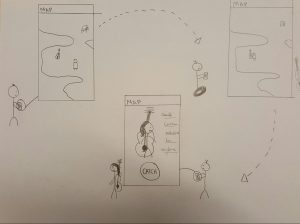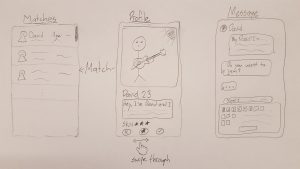Blog Update #7a – Final Conclusions and Recommendations
When comparing proximity versus geolocation methods, we had found that both methods were valid approaches when implemented for social gathering applications, more specifically for connecting musicians with each other. The geolocation approach was found to be more user-friendly by the transfer effects from other applications. On the other hand, we had theorized that proximity could create bonds between users. However, the result remained inconclusive due to the deviated direction of the experiment design. To summarize, it was concluded one was not better than the other for populating users in a social application and was found to primarily depend on user preference when choosing between the two methods. This could have been due to our experiment design implementation, which could have handled the execution in a more controlled manner, like the implementation of two prototypes where one would have implemented geolocation as a control and the other proximity, instead of using a currently commercially available application as the control.
Overall, even though our findings were inconclusive, we found proximity methods to be a valid approach when used for populating a list of users, though adjustments are needed if future experiments are to determine whether proximity is a better approach when compared to geolocation. Current applications in the market have similar use cases for proximity and geolocation for populating a list of people in social applications, however, proximity based-methods were not found to be implemented in social music applications. Further investigation needs to be done to determine whether or not proximity is a better approach in establishing bonds with other users as opposed to geolocation. Conclusive results between the two approaches can help in the development of other future or current FriendFinder applications since the two approaches are not limited to only social music applications.
In an effort to investigate whether the proximity approach would help to establish bonds between users, the next logical step to take would be to run a more in-depth study involving more participants, while having users use the proximity-based application for a prolonged period of time. This will help users feel a sense of realism when developing connections in the application while providing a better approach for studying how a head counter (how many times a user passed by another user) helps users connect with other people.
Blog Update #7b – Reflection on Your Design and Evaluation Process
Throughout the course of the design process, our actual interface design and approach remained relatively constant. Many aspects of our design were inspired by commercial applications already in existence which validated the interface design and concept in advance. The results gathered from our initial field study supports this fact. Initially, we created two designs for the profile page in the application which were amalgamated into one following the initial field study, but only minor changes were made to other aspects of the interface. Certain features allowing the user to gather a better understanding of the musician ‘at a glance’, such as the music sample and skill level were brought to the forefront of the application based on feedback from the first field study. Conceptually however, the design choice of utilizing a proximity based system to connect musicians with each other remained constant throughout.
A major pain point heading into the development of the medium fidelity prototype that was not foreseen was the ability to dynamically generate the list of matches in the application that the study participant had presumably passed at some point. The introduction of the walk around the building in the second field study was then introduced to convince the participant they had just recently passed other users that were also in the application. Ultimately it was difficult to convince participants these encounters had just occurred and detracted from the reality of the experiment.
Every method applied in this study were effective in some capacity in helping us to validate our hypotheses. A semi-structured interview was carried out initially to help us explore the problem space. Observation and semi-structured interviews were later used to evaluate the usability of our design concept and prototypes. However, the methods chosen for our evaluations would have been more effective in a long-term study with participants using the application throughout the course of a week to two weeks. Also, tasks assigned to the participants to carry out could have been more open-ended and less structured to allow participants to choose the users they personally enjoyed.
Interviews, field study, pilot study, and observation were found to be the most useful methods used in the studies. Semi-structured interviews were conducted twice throughout the course of the project and allowed us to gather insightful information about our participants which we found to be of the most value. Observation and field studies were used once in the project for the purposes of evaluating our medium fidelity prototype. Through observation, we gained a much deeper understanding of the weaknesses and strengths of our interface that we had not seen before. Lastly, the pilot study was another useful method that we used for pre-determining the flaws of our interface before putting it into the real field study. On the other hand, the questionnaire from our initial field study was found to be the least helpful, mainly because the results did not really aid much in the studying of our participants. Overall, many methods we applied were crucial to the success of this study.

 Photo taken by Edward Lee
Photo taken by Edward Lee Photo taken by Michael Williams
Photo taken by Michael Williams